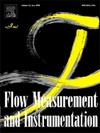An improved optical method for spatial phase distribution measurement of slug flow in small channels
IF 2.3
3区 工程技术
Q2 ENGINEERING, MECHANICAL
引用次数: 0
Abstract
This work presents an improved optical method which can fully exploit the light intensity distribution information for measuring spatial phase distribution of slug flow in small channels. Two high-speed CMOS array sensors (in horizontal and vertical directions) are used to capture the information of light intensity distributions (including the straight-line and the curved light intensity distributions). A spherical surface geometric model is used to characterize the spatial phase distribution of the gas-liquid two-phase interface of slug flow more accurately. In addition, the measurement correlations between the geometric features of spatial phase distributions and the characteristics of light intensity distributions are analyzed and the measurement model is established. The improved method not only considers the phase distribution characteristics of each independent cross-section, but also extends the correlations and measurement model to the three-dimensional spatial phase distributions through integrating the light intensity distribution information, realizing more accurate profile reconstruction. Experiments are carried out in three small channels with different inner diameters. The reconstructed profiles of spatial phase distributions are in good accordance with the actual images and show more details in the nose and tail parts of the gas slugs, with the maximum average symmetric surface distance of 0.2779 mm. The void fraction is subsequently estimated, with the maximum absolute error of −4.91 % and the maximum root mean squared error of 0.0264. The research results show the effectiveness and enhanced accuracy of the improved method compared with other optical methods, which can provide a useful reference for other related works.
小通道段塞流空间相位分布测量的改进光学方法
本文提出了一种改进的光学方法,可以充分利用光强分布信息来测量小通道段塞流的空间相位分布。利用两个高速CMOS阵列传感器(水平方向和垂直方向)捕获光强分布信息(包括直线光强分布和弯曲光强分布)。采用球面几何模型更准确地表征了段塞流气液两相界面的空间相分布。分析了空间相位分布的几何特征和光强分布特征之间的测量相关性,建立了测量模型。改进后的方法不仅考虑了各个独立截面的相位分布特征,而且通过整合光强分布信息,将相关关系和测量模型扩展到三维空间相位分布,实现了更精确的剖面重建。实验在三个不同内径的小通道中进行。重建的空间相位分布剖面与实际图像吻合较好,且在气塞头和尾部分显示出更多细节,最大平均对称表面距离为0.2779 mm。随后对孔隙率进行估算,最大绝对误差为- 4.91%,最大均方根误差为0.0264。研究结果表明,与其他光学方法相比,改进方法的有效性和精度得到了提高,可为其他相关工作提供有益的参考。
本文章由计算机程序翻译,如有差异,请以英文原文为准。
求助全文
约1分钟内获得全文
求助全文
来源期刊

Flow Measurement and Instrumentation
工程技术-工程:机械
CiteScore
4.30
自引率
13.60%
发文量
123
审稿时长
6 months
期刊介绍:
Flow Measurement and Instrumentation is dedicated to disseminating the latest research results on all aspects of flow measurement, in both closed conduits and open channels. The design of flow measurement systems involves a wide variety of multidisciplinary activities including modelling the flow sensor, the fluid flow and the sensor/fluid interactions through the use of computation techniques; the development of advanced transducer systems and their associated signal processing and the laboratory and field assessment of the overall system under ideal and disturbed conditions.
FMI is the essential forum for critical information exchange, and contributions are particularly encouraged in the following areas of interest:
Modelling: the application of mathematical and computational modelling to the interaction of fluid dynamics with flowmeters, including flowmeter behaviour, improved flowmeter design and installation problems. Application of CAD/CAE techniques to flowmeter modelling are eligible.
Design and development: the detailed design of the flowmeter head and/or signal processing aspects of novel flowmeters. Emphasis is given to papers identifying new sensor configurations, multisensor flow measurement systems, non-intrusive flow metering techniques and the application of microelectronic techniques in smart or intelligent systems.
Calibration techniques: including descriptions of new or existing calibration facilities and techniques, calibration data from different flowmeter types, and calibration intercomparison data from different laboratories.
Installation effect data: dealing with the effects of non-ideal flow conditions on flowmeters. Papers combining a theoretical understanding of flowmeter behaviour with experimental work are particularly welcome.
 求助内容:
求助内容: 应助结果提醒方式:
应助结果提醒方式:


